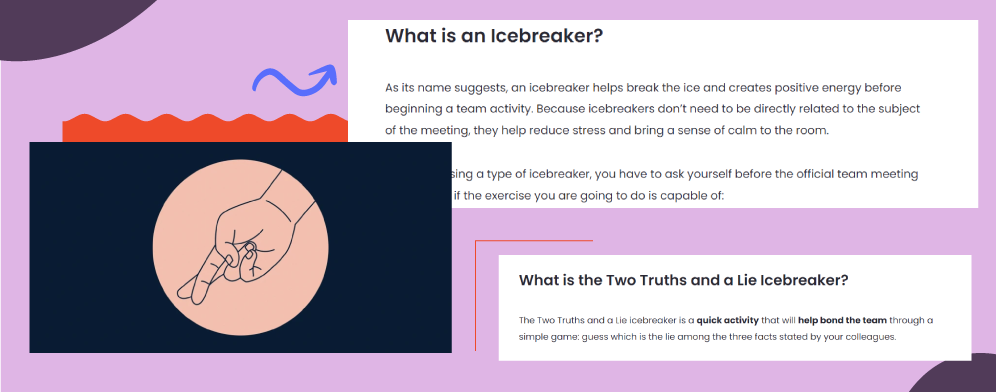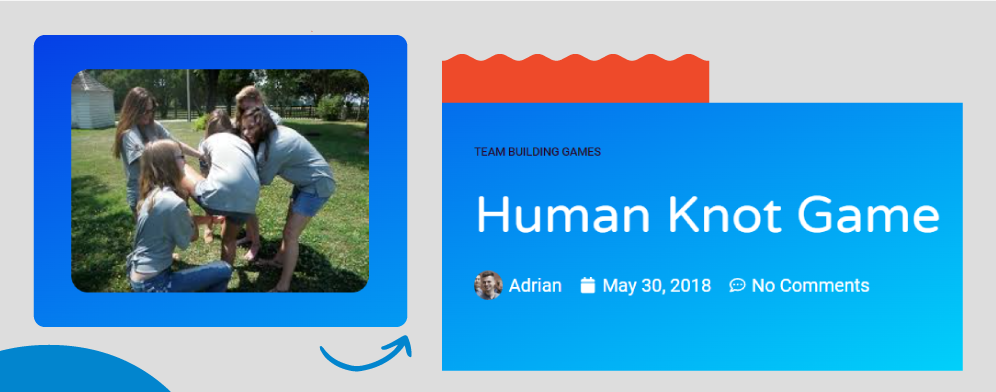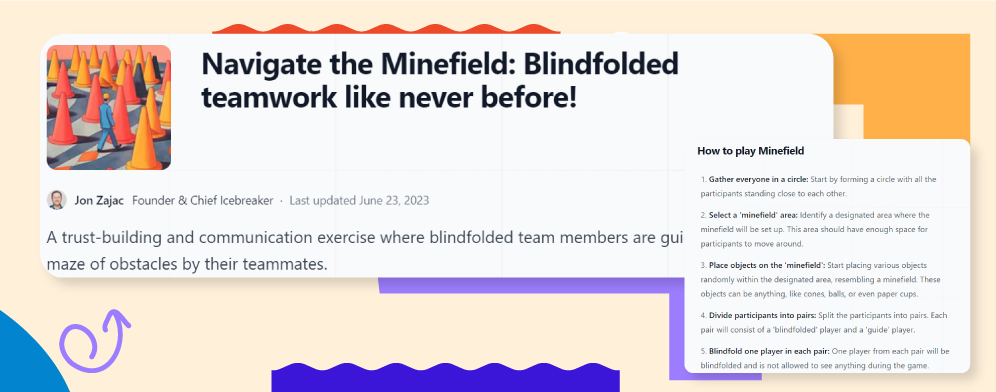1. How Do Team Building Activities For Communication and Trust Benefit Employees?

1.1. Creates a Sense of Belonging
When people work together to achieve the same goal, it fosters unity among the participants. This shared sense of purpose and accomplishment builds trust and encourages open communication, as team members become more comfortable with each other, ultimately enhancing collaboration and camaraderie in the workplace.
1.2. Promotes Cultural Sensitivity

Working together through team building activities allows participants to witness the collective effort of everyone in the group. These activities will enable them to appreciate everyone’s diverse backgrounds and what makes them unique.
After all, people have more similarities than differences, and realizing this can do wonders for camaraderie on an individual level and long-term success for the collective.
1.3. Boosts Employee Morale
Everyone can participate in simple team building activities—they are designed such that people of all ages and skill levels can enjoy them. They are the perfect way to ensure employees feel appreciated. They create a fun and positive environment to further motivate your employees and improve overall morale.
1.4. Reduce Conflicts

Team building activities for communication and trust provide a comfortable environment for your employees to practice how to handle conflicts among other participants and teammates. Because the stakes are relatively lower compared to the workplace, everyone can express themselves more freely and gain a closer look at each other’s perspectives.
This helps pave the path to conflict resolution during the activity and at work. This is incredibly important for teams to continue to work well together through the challenges they face.
1.5. Increases Empathy
Team building activities help participants understand each other better, which leads to respect for each other’s opinions even when they disagree.
When your employees get a closer look into each other’s perspectives, they are more empathic and supportive of one another—another critical element of a cohesive, efficient, and ultimately successful workplace.
2. 12 Best Team Building Activities to Promote Communication and Trust
2.1. Truth & Lies

Truth and Lies requires all the players to come up with three truths and one lie about themselves. The players read their statements aloud while the others guess which one is the lie. At the end of each round, the host reveals the answer.
This is a fun activity where players can get creative with their statements and have fun guessing for others. Throughout the activity, team members get to share interesting facts about themselves in a casual environment. This inturn strengthens bonds and builds communication skills for everyone making it a popular choice in team building activities for communication and trust.
Team Size: 5 or more
Duration: 15 to 30 minutes
2.2. Island Survival
Island Survival emulates a scenario where participants have been stranded on an island after a shipwreck. Each team is stranded, and only 20 items have washed up on the shore. They must choose five things to keep for their survival, and they must do so within a set time limit.
And then, the team will take turns presenting their chosen items and explaining why they are among the five most important ones they “found” on the shore. The team that best defends their choices—or the one most likely to survive—wins.
This is unlike other team building activities for communication and trust. It’s a quick and easy game that requires participants to strategize, cooperate, and communicate complex ideas. Participants must defend their choice of items and outline their benefits, which is a great way to improve communication skills.
Team Size: 5 to 10
Duration: 30 minutes
2.3. The Perfect Square
You need a large open space and a long piece of rope arranged in a circle. To begin, participants stand in a circle while holding the rope. Then, they put the rope down and are given a blindfold. They must put it on and walk a short distance away from the circle. Then, ask them to get back to the ring and try forming a square while blindfolded.
This is an excellent choice in team building activities for communication and trust for fostering leadership and problem-solving skills. Blindfolded activities are fantastic lessons in successful teamwork and communication.
Team Size: 5 to 20
Duration: Variable
2.4. Drawing With Instructions
Guided drawing is one of the easier.communication team building activities for small groups. This is done in pairs among participants—they sit back to back with each other. One participant has a pencil and a piece of paper, while the other is given a picture or an object. The one with the pencil will be guided to draw the picture through verbal communication.
This activity has earned its place in our roster of team building activities for communication and trust. It's a stimulating challenge that actively encourages participants to fine-tune their abilities in both attentive listening and effective instruction delivery.
Team Size: 2 per group
Duration: 5 to 10 minutes
2.5. Crisis Simulation
Conduct a crisis simulation by organizing employees into groups of 4 or 6 and presenting them with a work-related crisis scenario. Their task is to collaboratively solve the issue within a set time frame. Each team must devise solutions and preemptive strategies to address the crisis effectively.
This activity is one of the best trust building exercises for leadership teams, equipping them with essential skills for managing high-pressure situations in the workplace, while simultaneously honing problem-solving and brainstorming abilities for all participants.
Team Size: 4 to 6 members in groups
Duration:45 to 60 minutes
2.6. The Human Knot

To set up the Human Knot activity, get everyone to stand in a circle. Ask everyone to hold hands with any two people except for those immediately to their left and right. Then, ask them to unravel the human knot without letting go of each other’s hands.
This activity serves as an engaging team-building exercise that requires clear communication and precise coordination. As participants work together to untangle the knot, they learn to trust one another, problem-solve in a dynamic environment, and build a sense of unity.
Team Size: 8 to 20
Duration: 20 minutes
2.7. The Barter Puzzle
Divide participants into equal groups of 4 or more. Each team is given a jigsaw puzzle with the same difficulty level. Right before the activity, shuffle pieces from each puzzle into other puzzle boxes to provide each team with mismatched pieces. The group that completes their puzzle fastest wins—but they can only get the missing parts from other teams using negotiations and trade tactics.
In the Barter Puzzle, participants are required to work together, fostering open communication, trust, and collaboration. As teams trade pieces with one another, they learn the importance of effective negotiation and the significance of cooperative problem-solving, making it an engaging and enlightening experience for all involved.
Team Size: 3 to 4
Duration: 20 minutes
2.8. Group Storytelling
In this engaging activity, each person in the circle contributes to an unfolding story, building upon the narrative introduced by the individual next to them. As the story weaves its way around the circle, individuals not only exercise their listening skills to grasp the context and details presented by their peers but also hone their speaking abilities to build upon the storyline effectively.
This activity encourages creative thinking, cooperation, and adaptability, as participants must adapt their contributions to fit the evolving narrative. For those who are in a remote setup or have distributed teams, group storytelling can easily be adapted online and is one of the best virtual team building activities for communication and trust.
Team Size: Flexible
Duration: 30 minutes
2.9. Escape Room Challenge

You can book a local Escape Room or set up one yourself by designing a series of puzzles. The players must solve all of them to get out of the room. You can form different groups and challenge them to finish the game before the timer runs out. The team that gets out first is the winner.
Escape Rooms are some of the most fun team building activities for communication and trust. All players must participate and brainstorm solutions to look for clues and solve puzzles. They must communicate effectively under pressure while also remaining patient and calm.
Team Size: 2 to 12
Duration: 1 hour
2.10. Communication Web
In the Communication Web activity, teams of 8 to 12 people form a circle. It begins with one person holding a ball of yarn and sharing a fact about themselves or something related to their work. Once they’re done, they pass the yarn to another person who relates to their story and wants to share something. As they do this, the person passing the thread holds onto a string, creating a complex web.
The web is a visual representation of how interconnected communication works. As participants actively listen to their colleagues' stories, they are not only encouraged to bond and connect but also to empathize and build stronger connections with one another.
Team Size: 9 to 12
Duration: 30 minutes
2.11. The Minefield

To play Minefield, you'll need a spacious area, whether indoors or outdoors, and various objects like balls and cones to act as "mines." Participants are paired up, with one blindfolded while the other acts as their guide, helping them navigate through the minefield without making contact with the scattered objects. For an added challenge, the blindfolded person is not permitted to speak.
The objective of this activity is to guide a blindfolded partner through the minefield, which demands considerable patience and exceptional communication skills. It also emphasizes the importance of following and trusting one's partner for a safe and successful journey through the obstacle course.
Team Size: 2 per group
Duration: 20 minutes
2.12. Communication Skills Training/Workshops
If you want to combine a couple of team building activities for communication and trust into one focused session, consider organizing a dedicated workshop. This workshop can incorporate a variety of activities designed to enhance employees' communication skills.
Through this training workshop, you can delve into crucial competencies like active listening, conflict resolution, and assertiveness. These sessions offer an effective platform for skill development through practical examples and hands-on exercises, fostering a deeper understanding of these vital skills.
Team Size: Not relevant
Duration: Variable
3. FAQs
3.1. How Do You Build Trust and Communication in a Team?
To build trust and communication in a team, listen more and speak less. Show sincere interest toward others and appreciate their effort when they reach out to you. Ask for feedback, act on it, and ensure consistency in your words and actions. Develop an inclusive culture focused on honesty and transparency.
3.2. What Are the 6 Communication Activities?
The top six communication activities include Truth and Lies, Drawing With Instruction, Minefield, Human Knot, Charades, and Group Storytelling.
3.3. What Are the 3 Fundamental Elements of Trust?
The three fundamental elements of trust are competency, integrity, and goodwill. All of these elements must be present if you’re trying to build trust between two or more individuals.
 Interested in Virtual Team Building Events?
Interested in Virtual Team Building Events?





















